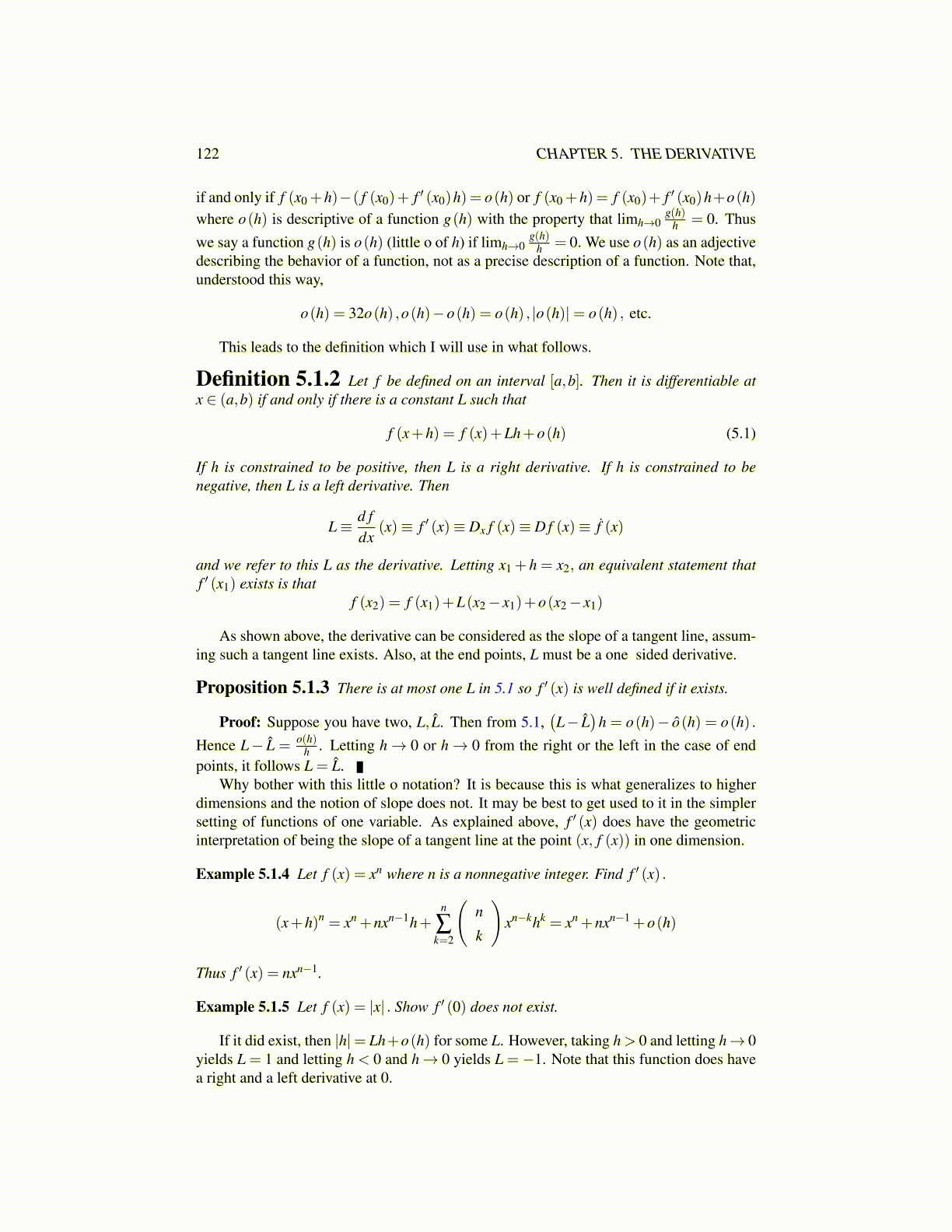
122 CHAPTER 5. THE DERIVATIVE
if and only if f (x0 +h)−( f (x0)+ f ′ (x0)h) = o(h) or f (x0 +h) = f (x0)+ f ′ (x0)h+o(h)where o(h) is descriptive of a function g(h) with the property that limh→0
g(h)h = 0. Thus
we say a function g(h) is o(h) (little o of h) if limh→0g(h)
h = 0. We use o(h) as an adjectivedescribing the behavior of a function, not as a precise description of a function. Note that,understood this way,
o(h) = 32o(h) ,o(h)−o(h) = o(h) , |o(h)|= o(h) , etc.
This leads to the definition which I will use in what follows.
Definition 5.1.2 Let f be defined on an interval [a,b]. Then it is differentiable atx ∈ (a,b) if and only if there is a constant L such that
f (x+h) = f (x)+Lh+o(h) (5.1)
If h is constrained to be positive, then L is a right derivative. If h is constrained to benegative, then L is a left derivative. Then
L ≡ d fdx
(x)≡ f ′ (x)≡ Dx f (x)≡ D f (x)≡ ḟ (x)
and we refer to this L as the derivative. Letting x1 + h = x2, an equivalent statement thatf ′ (x1) exists is that
f (x2) = f (x1)+L(x2 − x1)+o(x2 − x1)
As shown above, the derivative can be considered as the slope of a tangent line, assum-ing such a tangent line exists. Also, at the end points, L must be a one sided derivative.
Proposition 5.1.3 There is at most one L in 5.1 so f ′ (x) is well defined if it exists.
Proof: Suppose you have two, L, L̂. Then from 5.1,(L− L̂
)h = o(h)− ô(h) = o(h) .
Hence L− L̂ = o(h)h . Letting h → 0 or h → 0 from the right or the left in the case of end
points, it follows L = L̂.Why bother with this little o notation? It is because this is what generalizes to higher
dimensions and the notion of slope does not. It may be best to get used to it in the simplersetting of functions of one variable. As explained above, f ′ (x) does have the geometricinterpretation of being the slope of a tangent line at the point (x, f (x)) in one dimension.
Example 5.1.4 Let f (x) = xn where n is a nonnegative integer. Find f ′ (x) .
(x+h)n = xn +nxn−1h+n
∑k=2
(n
k
)xn−khk = xn +nxn−1 +o(h)
Thus f ′ (x) = nxn−1.
Example 5.1.5 Let f (x) = |x| . Show f ′ (0) does not exist.
If it did exist, then |h|= Lh+o(h) for some L. However, taking h > 0 and letting h → 0yields L = 1 and letting h < 0 and h → 0 yields L =−1. Note that this function does havea right and a left derivative at 0.